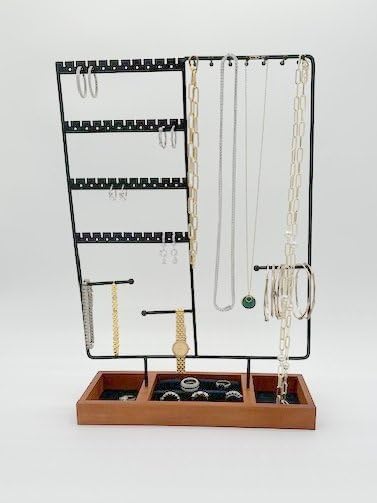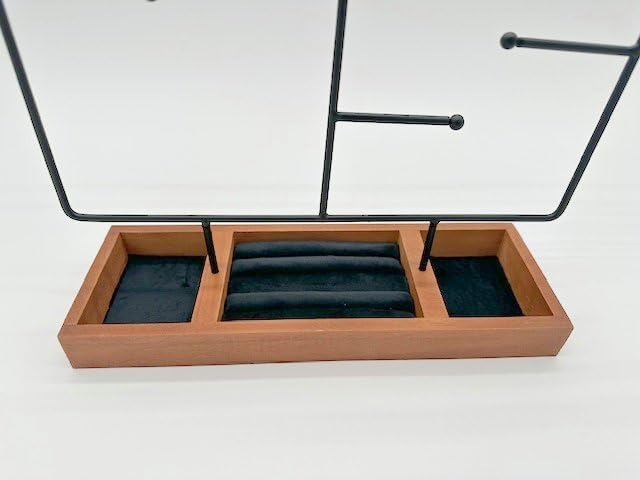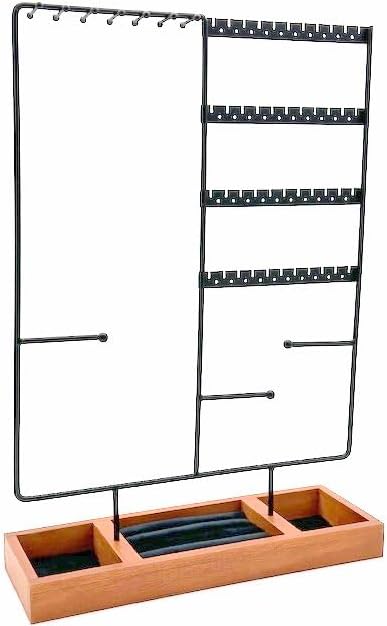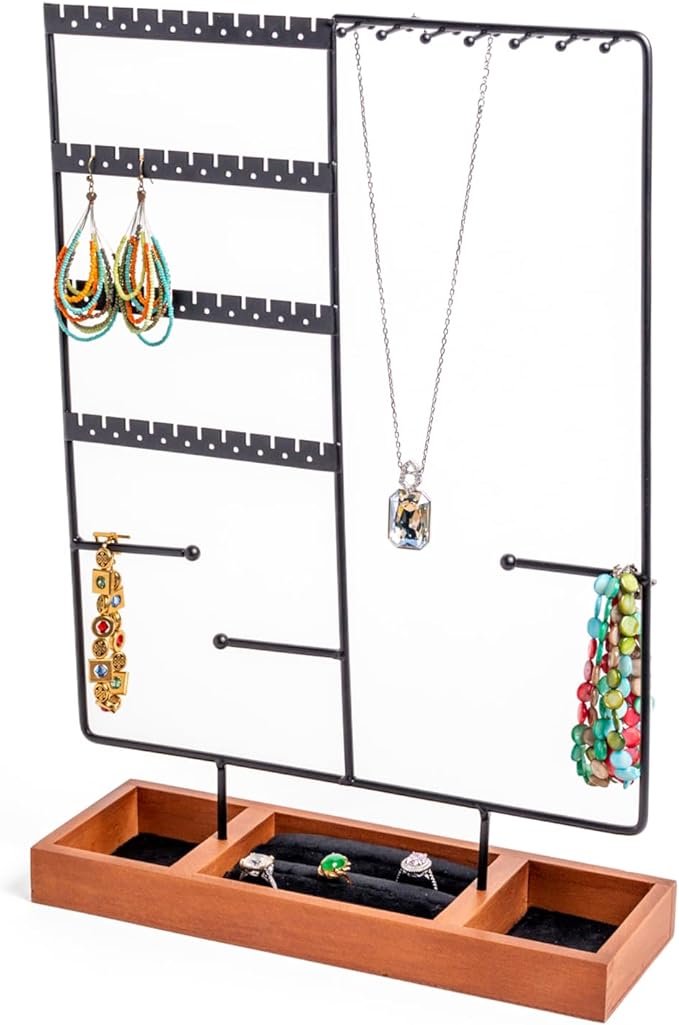Large 5 Tier Jewelry Organizer | Dresser Jewelry Organizer for Earrings, Necklaces, Bracelets, Rings, Watches | 14 Necklace Hooks, 20 Earring Holders, 2 Bracelet/Watch Hangers & Padded Ring Tray Black
Large 5 Tier Jewelry Organizer | Dresser Jewelry Organizer for Earrings, Necklaces, Bracelets, Rings, Watches | 14 Necklace Hooks, 20 Earring Holders, 2 Bracelet/Watch Hangers & Padded Ring Tray Black
Couldn't load pickup availability

DESCRIPTION
DESCRIPTION
ALL-IN-ONE ORGANIZER: With 5 Tiers, 14 hooks and 20 pair Earring Holder - Padded Ring Tray. This jewelry organizer can hold a variety of accessories, including earrings, necklaces, bangles, rings, watches, etc. Keep your jewelry collection organized and within easy reach.
PRACTICAL & MODERN: Our jewelry organizer stand is a cute piece for your dresser, creating a chic & minimalist room decor aesthetic while helping you organize your jewelry. Its high quality makes it lightweight yet sturdy.
TANGLE-FREE NECKLACE HOLDER: With this jewelry holder organizer, you can neatly hang your necklaces & prevent them from tangling. You can easily select any piece of jewelry without the hassle of untangling.
CONVENIENT STORAGE BOX: What sets our jewelry stand apart is the convenient storage box, providing additional space for neatly storing earrings, hair clips, and other accessories.
THOUGHTFUL GIFT CHOICE: This jewelry storage makes for a ideal gift for friends or family who love jewelry. Ideal for special occasions like Valentine's Day, Mother's Day, Thanksgiving, Birthdays, and Christmas.
PRODUCT DETAILS
PRODUCT DETAILS
Style: Jewelry Holder Organizer Stand with drawer
Type & Color: Black
Product Dimensions: 4"D x 11.75"W x 17"H
MORE DETAILS
MORE DETAILS
Shape: Rectangular
Color: Black
Material: Wood
Finish: Powder Coated
CERTIFICATION
CERTIFICATION
-
RETURN & EXCHANGE POLICY
RETURN & EXCHANGE POLICY
You have a 30-day window from when you receive your item to initiate a return or exchange. For a return or exchange to be valid, the item must adhere to the following conditions:
- The item should remain in its original condition.
- It should not have been worn or used.
- All original tags must be intact, and it should be in its initial packaging.
- A receipt or proof of purchase will be required.
Return/Exchange Policy Details:
Accepted Reasons for Returns/Exchanges:
We process returns and exchanges under the following circumstances:
- If the received product is damaged or incomplete.
- For loose moissanite diamonds (not jewelry), returns or exchanges are allowed for:
- Change of preference.
- Personal dissatisfaction with the product.
- Incorrect size ordered.
How to Request a Return/Exchange:
For initiating a return or exchange, please reach out to us. Upon approval of your request, we'll furnish you with a return shipping label and clear guidelines on packaging and dispatch. Please be informed that unsolicited returns without our prior consent will not be accepted.
Shipping & Delivery Information:
We are committed to providing a seamless shipping experience irrespective of your location. Our efficient team ensures swift processing of your order and timely delivery.
Estimated Delivery Time:
Anticipate receiving your order within 2-3 business days post-shipment.
Your satisfaction is paramount to us. Should you have any questions or need further clarification, feel free to contact us.





ADDITIONAL INFORMATION
Cubic zirconia (CZ)
Cubic zirconia (CZ) is a synthetic gemstone that closely resembles a
diamond in appearance but is much more affordable. It is a crystalline
form of zirconium dioxide and is often used as a diamond simulant in
jewelry. Here are some key points about cubic zirconia:
Composition: Cubic zirconia is composed of zirconium and oxygen
atoms arranged in a cubic crystal lattice structure. This crystal structure
is what gives CZ its optical properties, such as its brilliance and sparkle.
Appearance: CZ is renowned for its brilliance and fire, which means it
reflects and refracts light in a way that makes it sparkle. It can closely
mimic the appearance of a diamond, and many people use it as a less
expensive alternative.
Hardness: While cubic zirconia is a relatively hard material, it is not as
hard as a natural diamond. Diamonds are the hardest known natural
material, ranking at the top of the Mohs scale with a rating of 10. CZ, on
the other hand, typically ranks at 8-8.5 on the Mohs scale, which makes
it more susceptible to scratches and wear over time.
Color: CZ is often colorless, but it can be made in various colors by
adding trace elements during the manufacturing process. This allows
for a wide range of colored CZ gemstones.
Synthetic Production: Cubic zirconia is produced in a laboratory through
a process called the Verneuil method or the flame fusion method. It
involves melting zirconium dioxide powder at high temperatures and
then allowing it to crystallize.
Cost: One of the primary advantages of cubic zirconia is its affordability
compared to natural diamonds. CZ is significantly less expensive,
making it an attractive option for individuals on a budget or those who
want a diamond-like appearance without the high price tag.
Use in Jewelry: CZ is commonly used in jewelry, such as rings, earrings,
pendants, and bracelets. It is often set in various metals, including
sterling silver, gold, and platinum.
Durability: While cubic zirconia is durable enough for everyday wear, it
may not last as long as natural diamonds because it is more prone to
scratching and wear over time. However, with proper care, CZ jewelry
can maintain its beauty for a considerable period.
In summary, cubic zirconia is a synthetic gemstone that mimics the
appearance of a diamond at a much lower cost. It is widely used in the
jewelry industry and is a popular choice for those seeking an attractive,
budget-friendly alternative to natural diamonds.
Why Moissanite vs Real Diamonds
Moissanite is a popular alternative to natural diamonds for a variety of reasons. Here are some advantages of moissanite diamonds:
1. Cost-Effective: Moissanites are considerably less expensive than natural diamonds of similar sizeand quality. This affordability allows individuals to get a larger and more impressive-looking stone fortheir budget.
2. Brilliance and Fire: Moissanite has a high refractive index, which means it disperses light betterthan diamonds, resulting in more colorful flashes of light and a striking sparkle. This property is oftenreferred to as "fire."
3. Hardness: Moissanite is the second hardest naturally occurring mineral on Earth after diamond,ranking at 9.25 on the Mohs scale of hardness. This makes it highly durable and suitable for everydaywear, just like diamonds. Ethical and Eco-Friendly: Moissanites are created in a lab, so they do notinvolve the ethical concerns associated with some natural diamonds, such as "blood diamonds" orconflict diamonds. They are also a more environmentally friendly choice because their production doesnot require the extensive mining associated with natural diamonds.
4. Ethical and Eco-Friendly: Moissanites are created in a lab, so they do not involve the ethicalconcerns associated with some natural diamonds, such as "blood diamonds" or conflict diamonds. Theyare also a more environmentally friendly choice because their production does not require the extensivemining associated with natural diamonds.
5. Clarity and Color: Moissanites are typically very clear and near-colorless. They often have fewerinclusions (internal flaws) than natural diamonds, which can result in a higher clarity rating.
6. Size and Carat Weight: Due to their lower cost, individuals can afford larger moissanite stones,allowing for more creative and eye-catching jewelry designs.
7. Consistency: Moissanites are created in a controlled laboratory environment, which means theyhave fewer imperfections and variations compared to natural diamonds, making it easier to find a stonewith specific characteristics.
8. Uniqueness: Moissanite is not as common as natural diamonds, which may appeal to those whowant a unique or less traditional engagement ring or jewelry piece.
9. No Conflicts: Because moissanites are lab-grown, there is no involvement in conflicts or unethical practices often associated with the diamond industry. It's important to note that while moissanite offers these advantages, it may not possess the same rarity or emotional significance as natural diamonds for some people. Ultimately, the choice between moissanite and natural diamond depends on personal preferences, budget considerations, and ethical concerns.
Key points about lab-created diamonds, often referred to as Sona diamonds
Lab-created diamonds, also known as synthetic diamonds, are diamonds that are grown in a laboratory setting rather than being formed naturally in the Earth crust. These diamonds have gained popularity in recent years due to their ethical and environmental advantages, as well as their cost-effectiveness compared to mined diamonds.
Formation: Lab-created diamonds are made using two primary methods: High Pressure High Temperature (HPHT) and Chemical Vapor Deposition (CVD). HPHT mimics the high-pressure, high-temperature conditions under which natural diamonds form, while CVD involves the deposition of carbon atoms onto a diamond seed crystal.
Physical Properties: Lab-created diamonds have the same physical, chemical, and optical properties as natural diamonds. They have the same hardness (score 10 on the Mohs scale), brilliance, and fire.
Ethical and Environmental Benefits: One of the significant advantages of lab-created diamonds is that they are considered more ethical and environmentally friendly than mined diamonds. They do not involve the social and environmental issues often associated with diamond mining, such as conflict diamonds (blood diamonds) and habitat disruption.
Cost: Lab-created diamonds are typically more affordable than their natural counterparts, often priced at 20-40% less for similar quality and size.
Quality and Grading: Lab-created diamonds are graded using the same 4Cs criteria as natural diamonds: carat weight, color, clarity, and cut. They can be found in a range of qualities, from lower-quality industrial diamonds to high-quality gemstones.
Certification: Reputable laboratories, such as the Gemological Institute of America (GIA), provide certifications for lab-created diamonds, just as they do for natural diamonds. These certificates provide information about the diamond's quality and characteristics.
Uses: Lab-created diamonds are used in various applications, including jewelry, industrial tools, and scientific instruments.
Which diamond is right for you
In the world of man-made diamonds, Sona Simulated Diamond and Moissanite stand out as two of the most popular alternatives to traditional diamonds. Now what are the differences. In this detailed guide, we explore the intricacies of both stones, comparing their physical properties, aesthetic qualities, price points, and more. Choosing between a Sona man-made diamond and a moissanite diamond can be akin to picking between a luxury car and a sports coupe – both are outstanding, yet each has its unique charm. Before delving into their characteristics, let's briefly understand what they are.
What Is a Sona Diamond?
A Sona Diamond is a type of simulated diamond, meticulously crafted in a controlled laboratory environment. It is distinct from synthetic diamonds, which possess the same physical and chemical properties as their natural counterparts. Sona Diamonds, although made with real diamond carbon and a core of diamond crystals, serve primarily as an aesthetic alternative at a lesser cost.
What is Moissanite?
Moissanite is a naturally occurring gemstone composed of silicon carbide (SiC), discovered in 1893 by the French chemist Henri Moissan. He found it while examining rock samples from the Canyon Diablo meteor crater in Arizona. Initially thinking he had found diamonds, Moissan later identified the crystals as silicon carbide.
Due to its rarity in nature, most moissanite used in jewelry today is lab-grown. With its sparkling brilliance, moissanite rivals the luminosity of diamonds. Furthermore, its durability, measured by hardness, is second only to diamonds, making it a highly sought-after diamond alternative for rings, earrings, and other jewelry pieces.
Sona Simulated Diamond vs Moissanite
Affordability: Both Sona Simulated Diamonds and Moissanite emerge as wallet friendly alternatives to traditional diamonds. Yet, when setting your budget, expect to allocate a bit more for Moissanite. It's renowned hardness and mesmerizing fiery sparkle fetch a premium.
Aesthetic Appeal: Both these stones dazzle and draw admiration. Sona Simulated Diamonds closely mirror the timeless elegance of real diamonds. In contrast, Moissanite possesses a unique, vivacious sparkle, discernible by gemstone enthusiasts.
Robustness: On the Mohs scale of mineral hardness, Moissanite shines with its impressive durability, almost rivaling diamonds. While Sona Simulated Diamonds might not boast the same robustness, they are resilient enough for everyday wear, ensuring longevity.
Eco-Footprint: In today's eco-conscious era, the environmental credentials of both these stones are noteworthy. As they are lab-grown, they circumvent the environmental pitfalls associated with mining. Moissanite's story, intertwined with meteor craters, adds an intriguing layer for those enamored by the mysteries of the cosmos.
Versatility in Adornments: Whether you're dreaming of a radiant engagement ring or a pair of dazzling earrings, both these gemstones fit the bill splendidly. The final selection, whether the classic allure of Sona Simulated Diamonds or the unique shimmer of Moissanite, rests on individual tastes and desires.
Which One is Right for You?
Your choice between Sona Simulated Diamond and Moissanite boils down to personal preference. If you desire the timeless elegance of a traditional diamond without the hefty price tag, the Sona Simulated Diamond is an ideal pick. However, if you are drawn to a distinct, vibrant sparkle and are looking for a unique gem that stands apart from conventional diamonds, Moissanite is your go-to.
Basic Facts:
How long do Sona diamonds last?
Sona diamonds, with proper care, can last a lifetime. However, they might lose some of their brilliance over time.
Is moissanite a good substitute for diamonds?
Absolutely! vMoissanites are not only more affordable but often more brilliant than real diamonds. They're also almost as hard, making them an excellent choice for everyday jewelry.
Can jewelers tell the difference between Sona diamonds and real ones?
Yes, experienced jewelers and gemologists can distinguish between the two using specialized equipment.
Are there any ethical concerns associated with moissanite?
No. Especially with lab-created moissanite, there's minimal environmental impact and no concerns about unethical mining.
Why choose a Sona diamond over a natural diamond?
Primarily, the affordability. Sona Diamonds also promise a great purchase, free from the concerns of "blood diamonds" or unethical mining practices.
Conclusion
In the quest for the perfect gemstone, both Sona Simulated Diamond and Moissanite present compelling options. Each stone offers a blend of beauty, durability, and affordability. By understanding their properties and comparing their features, you can make an informed decision that aligns with your personal taste and budget.





